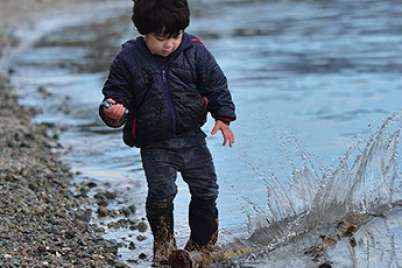
Stop talking about “risky play” for kids and use “adventurous” instead
This might sound surprising coming from the executive director of the Outdoor Council of Canada, but when it comes to encouraging kids to play outside, we don’t do ourselves or our children any favours by using the term “risky play”.
Our society has come to associate risk with hazard, but risk as defined by the International Standards Association in 2010, is the effect of uncertainty on objectives (ISO 31000-10). Meaning that risk doesn’t necessarily equal a good or bad outcome, just an uncertain one.
There’s a big difference between how much risk a child believes there might be (perceived risk) and the actual risk to their safety (objective risk). It’s up to parents, caregivers, educators, and program leaders to do a careful analysis and make sure that the objective risk is much, much lower than the perceived risk. This will ensure that kids can enjoy the enrichment of active outdoor time that should be part of every child’s experience from birth to Grade 12.
Because though we want to mitigate the danger of our kids hurting themselves as much as possible, in order to develop and grow properly, they need to feel adventurous. They need to feel like the outcome of their play is somewhat uncertain. This is important for both the individual child and also for our society as a whole.
So when we talk about advocating for healthy, balanced play time for kids let’s lose the word risk and focus instead on adventure. It’s more positive, reflects the experience we actually want kids to have, and doesn’t pressure parents to be overly casual about managing real risks for fear of being seen as helicopter parents.






Thanks for the article Albi. I completely agree!
Have you ever heard of the school in New Zealand a few years ago where they stopped enforcing rules in their recess times to see what happened? Turns out the kids actually had a safer time and were more attentive in their respective classes afterwards. It’s pretty fascinating…
news.nationalpost.com/news/…-surprised
By not exposing our kids to risks now, we put them at ever greater as they grow up. If they aren’t exposed to a wide variety of risks growing up, they never learn to identify and mitigate risks. That’s a recipe for disaster. They’ll grow up to either avoid anything that vaguely resembles a risk (and miss out on vast opportunities) or to boldly go out into the world oblivious of the risks they encounter or how to mitigate them. We should all do our kids a favor and put them in harm’s way every now and then. Or at least not scare them by calling good old fashioned childhood adventure “risky”.
I appreciate both the article and the dialogue that’s been happening here. As a high school teacher, I have seen the benefits that engaging in adventurous activities have on students’ lives and how these benefits carry into their lives both inside and outside the classroom. It would be awesome to see more educators and school districts engaged in bringing adventure into the classroom without getting overwhelmed and/or frightened by the risks. I think that changing some of the language we use and understanding the reality of risk is an important first step.
Hi Shawna – a note to objective risk.
These are deep waters, but you are right – since risk is in the experience of the beholder there is technically no such thing as ‘objective risk’. However, there are sophisticated techniques for assessing the probabilities of a particular outcome occurring and the severity of that outcome. This is what we typically mean by ‘objective’ risk, and to not assess it and act accordingly would be utterly irresponsible. Indeed, it is to avoid the ‘objective’ risks of sedentary and indoor play that we advocate adventurous play.
Hi Shawna, I agree with much of what you have to say including the meaning of the various words you define. Absolutely children must engage in play that they perceive as risky. But I fail to see how we are engaging the ‘crux of this issue’ by describing adventurous play as ‘risky’ when it is much less risky than sedentary and/or indoor play.
If we want to engage the ‘crux of this issue’ head on we need to be very clear that every choice we make for our children carries risks, but that adventurous play is actually a powerful tool that a parent or care-giver can use to minimize life-risks for children. By acknowledging that all options carry risk we open the next door in the debate which is how to facilitate adventurous play in a manner that is consistent with minimizing the chance of a catastrophic (life altering) acute injury to an acceptable level.
A particular concern that I have about the term risky play is that unless we make clear the difference between the risks that the child perceives and the objective risks of the activity, we empower care-givers to be lazy about the latter. This will not work out well. Let’s not forget that acute injury is the #1 cause of death and catastrophic disability for men under 40 and women under 30.
This is not an academic distinction. In 2003 seven youths died in an avalanche on a school trip where one of major pedagogical goals was to empower the students to build the capacity to face and manage risk. This is a great goal, but it can only be realized if the nature of the risks can actually be appreciated and managed by the student. The particular objective risks they faced that day were completely outside of their ability to understand and manage. There were other uncertainties and challenges they faced that day that could have satisfied the pedagogical goals, but they could have been as easily and completely achieved by choosing a trip with minimal or no avalanche hazard.
The key issue that needs to identified and corrected in this post is the use of the term ‘objective risk’. That does not exist. All risk is subjective. Risk is a dynamic, fluctuating probability. How do we support children to learn, assess and manage risk during play and throughout their life course when we avoid a term that may simply need to be reframed. Children and competent and capable. Let’s support them to learn and build core skills that are arguably fundamental to physical literacy – confidence, responsibility, knowledge, understanding:
“Physical literacy can be described as the motivation, confidence, physical competence, knowledge and understanding to value and take responsibility for engagement in physical activities for life.”
(Whitehead, 2016)
The popular meaning of risk needs to be dealt with heads on so that kids are free to play.
There are very important distinctions between risk, challenge, hazard and harm. Risk is the possibility of gaining or losing something of value, with an intentional interaction with uncertainty and probability. It varies from person to person. A hazard is a potential source of harm and a challenge is a risk that a person chooses to engage in or not. Harm is defined as hurt or damage. It is what we want to avoid.
Adventure includes risk, otherwise it would not be an ‘exciting, typically hazardous experience or activity’. It is exciting and/or dangerous by our society’s description. Without the risk element, it does not provide the opportunity for thrill, challenge and learning.
We advocate for using language that accurately defines the crux of this issue and not avoiding a term because of the subjective value judgement we have placed on it. There is a measure of risk that every child needs to develop, grow and experience the joy and freedom that authentic play can provide.
Let’s continue this dialogue and not avoid the issue by choosing different language.
This is exactly what I thought when I learned of this new trend/semantics discussion. Taking risks is not just about physical, outdoor, gross motor play. Some children are taking risks when they ask someone to play with them. Some children are taking risks when they eat a vegetable they didn’t like the last time they tried it. The important thing for educators is that they understand their roles in creating the safe space where children can step out of their comfort zones (no matter what those might be) and experience success in doing so. This reduces anxiety in new/unknown situations and supports children in developing the skills to face challenges head on rather than avoiding uncomfortable situations. The reality is that humans can’t and don’t learn ANYTHING unless they take the risk of stepping out of their comfort zones and into the unknown. Risky play is important to all domains of development and is not limited to climbing trees.